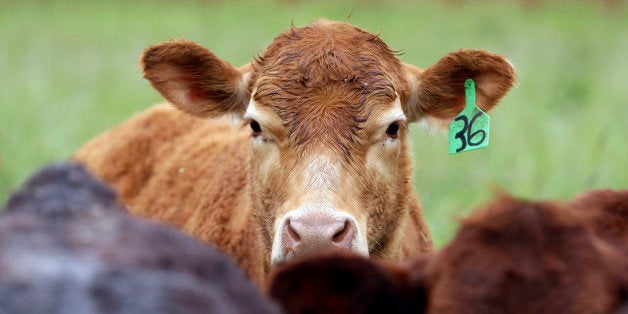
Here in California, the record-breaking, headline-making drought is always on our minds. A NASA scientist warns that we may have just one year's worth of water left, and Governor Jerry Brown has urged us all to cut our showers short and let our lawns go brown.
But the governor's plea won't solve California's water woes -- nor will it address the underlying cause of the crisis. When the commercial and residential sectors are responsible for a mere 20 percent of the state's water use, shorter showers will offer barely more than a drop in the near-empty bucket. The real culprit is not the water wastage in our bathtubs and fountains, or even on our golf courses -- it's on our plates.
Agriculture accounts for 80 percent of California's water consumption, and animal agriculture and feed crop production comprise the vast majority of that use, making them by far the biggest water guzzlers in the state. This is true nationally as well; agriculture accounts for between 80 and 90 percent of the fresh water used in the United States, and at least half of that goes to raising and feeding farmed animals.
That's because the real "water cost" of producing a single pound of meat can be as much as 1,800 gallons. That means producing just one hamburger requires the same amount of water as two months' worth of showers. By contrast, the water cost of a pound of potatoes is only 34 gallons.
Media coverage of the California drought often points the finger at almonds, which are indeed a very thirsty crop. By some estimates, they require up to a gallon of water per nut. But forage and alfalfa, commodities grown almost exclusively to feed beef and dairy cattle, use about four times more water than almonds. The state's millions of cows eat much of this hay, but California also exports about 100 billion gallons of water per year in the form of alfalfa to Asia, where meat- and dairy-heavy Western diets are taking hold. That's 1,400 times more water than the California fracking industry -- another subject of media scrutiny -- uses in an entire year.
Despite these telling figures, the California meat, dairy, egg and feed grain industries like to paint themselves as victims of the drought. This has earned them the good graces of Governor Brown, who imposed a mandatory 25 percent water restriction on all California residents but left factory farmers untouched. That's like addressing a dire air pollution problem by banning a few small cars from the road while encouraging giant factories, trucks and other smog-belchers to continue with business as usual.
Far from a victim, animal agriculture is largely to blame, not only for the dangerous depletion of the state's water supply, but also for the drought's greatest underlying cause: climate change. According to the United Nations, the livestock industry contributes more to this global crisis than the entire transportation sector.
The good news is that each of us can dramatically reduce our water and carbon footprints by withdrawing our support of this wasteful industry. Vegetarian diets require on average about 60 percent less water than meat-based ones. And the most compassionate, healthful diets -- those that exclude all animal products -- require even less.